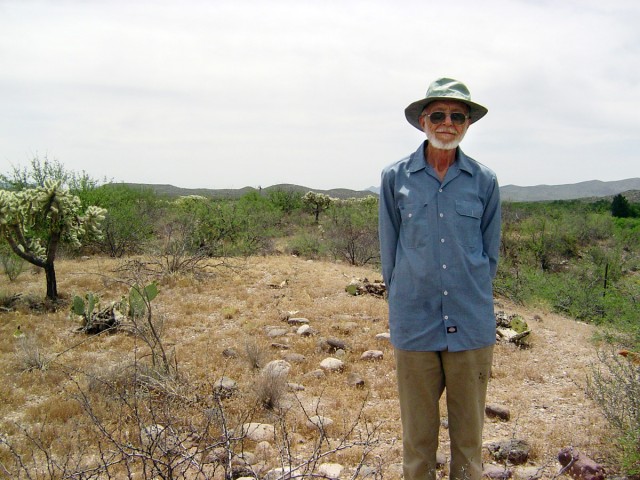In 2002, Harold and Dorothy (known as “Mignon”) Elliott donated an archaeological conservation easement to Archaeology Southwest (then known as the Center for Desert Archaeology). The conservation easement was over 55 acres of their deeded lands in Cochise County, Arizona, along the San Pedro River.
The easement’s principal purpose was long-term preservation of cultural resources, specifically Hohokam and Salado habitation areas and agricultural features known to exist on the property. Given Archaeology Southwest’s long-standing research program along the archaeologically rich lower San Pedro River, and given our mission to safeguard the places of the past, we were pleased to accommodate the Elliotts’ conservation aspirations for their land. This was our first conservation easement; we now hold seven conservation easements in Arizona and New Mexico.
Well before Archaeology Southwest became involved, the Elliotts built a passive solar house and several outbuildings on the interior of their 55-acre parcel. To accommodate that prior development, our conservation easement included a 2-acre residential zone around the Elliotts’ house. This zone was relatively unencumbered, in that it simply required the landowners to notify Archaeology Southwest if any work involving subsurface disturbance was to take place. This would allow Archaeology Southwest to monitor such activities for the presence of archaeological remains. If an archaeological monitor identified human remains, state law required the landowners to notify the Arizona State Museum. Thus, apart from notification, the easement did not impose any greater landowner obligations within the 2-acre residential zone, other than what Arizona law requires. The other 53 acres were subject to greater restrictions.
In early 2014, Mr. Elliott proposed that we expand the size of the residential zone to 4 acres, because the 2-acre area did not include much land beyond the footprint of existing buildings and the driveway. Essentially, Mr. Elliott was asking that we lift restrictions (other than notification) on 2 more of the 53 acres near the house. We informed Mr. Elliott that we were not in a position to do this without some benefit to our long-term preservation objectives. A few weeks later, Mr. Elliott proposed to convey us 51 acres in fee—basically, to sell us those 51 acres—in return for releasing 4 acres (the existing 2-acre residential zone and an additional 2 acres that were otherwise subject to significant restrictions).
An archaeologist resurveyed the property to determine if there were 2 acres contiguous with the existing 2-acre residential zone that did not contain any cultural resources. Survey demonstrated that 2 acres immediately north of the house did not appear to have any archaeological remains. Upon further analysis, Archaeology Southwest concluded that fee ownership of 51 acres would greatly benefit preservation, whereas the removal of 4 acres from the easement—given that those four acres did not appear to hold significant cultural remains—would not be detrimental. Moreover, current zoning in the region does not allow parcel sizes smaller than 4 acres, so the intensity of residential development on the 4 acres was not likely to change drastically, even without the strictures of the conservation easement.
Archaeology Southwest believes strongly in our responsibility to steward a conservation easement in perpetuity. We consider changes to a conservation easement only when conflicts with the original preservation goals are negligible and when such changes would increase preservation benefits. In some instances, changes are also necessary for clarifying provisions in the conservation easement.
